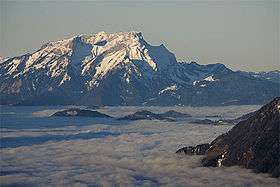Pilatus (mountain)
| Pilatus | |
|---|---|
|
East side | |
| Highest point | |
| Peak | Tomlishorn |
| Elevation | 2,128 m (6,982 ft) |
| Prominence | 585 m (1,919 ft) [1] |
| Isolation | 16.7 km (10.4 mi) [2] |
| Parent peak | Brienzer Rothorn |
| Coordinates | 46°58′26″N 8°14′28″E / 46.97389°N 8.24111°ECoordinates: 46°58′26″N 8°14′28″E / 46.97389°N 8.24111°E |
| Geography | |
 Pilatus Location in Switzerland | |
| Country | Switzerland |
| Cantons | Nidwalden and Obwalden |
| Parent range | Emmental Alps |
| Topo map | Swiss Federal Office of Topography swisstopo |
| Climbing | |
| First ascent | 14th century |
| Easiest route | Pilatus Railway (world's steepest cogwheel railway) |
Pilatus (also often referred to Mount Pilatus) is a mountain massif overlooking Lucerne in Central Switzerland. It is composed of several peaks, of which the highest (2,128 m (6,982 ft)) is named Tomlishorn and is located about 1.3 km (0.81 mi) to the southeast of the top cable car and cog railway station. The two peaks right next to the stations are called Esel (Donkey, 2,118 m (6,949 ft)), which lies just east over the railway station, the one on the west side is called Oberhaupt (Head-Leader, 2,105 m (6,906 ft)). Jurisdiction over the massif is divided between the cantons of Obwalden (OW), Nidwalden (NW), and Lucerne (LU). The main peaks are right on the border between Obwalden and Nidwalden.
Railway and summits
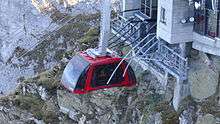
The top can be reached with the Pilatus Railway, the world's steepest cogwheel railway, from Alpnachstad, operating from May to November (depending on snow conditions), and the whole year with the aerial panorama gondolas and aerial cableways from Kriens. Both peaks next to the top stations, Esel and Oberhaupt, can easily be reached also by mass tourism.
The highest peak however, Tomlishorn, and the other peaks, such as Widderfeld (2,128 m (6,982 ft)) even further west than the Tomlishorn on the border between LU and OW, Matthorn (2,040 m (6,690 ft)) to the south, the Klimsenhorn (1,906 m (6,253 ft)) to the north (UW), and Rosegg (1,974 m (6,476 ft)) and Windegg (1,673 m (5,489 ft)) to the east, both on the border of UW and OW, should only be approached with appropriate Alpine hiking equipement.
The whole mountain range streches at least from the Lopper just opposite from Stansstad to the east as far as at least to the Mittaggüpfi (1,917 m (6,289 ft)) and the Risetestock (1,759 m (5,771 ft)) to the west on the border between LU and OW.
During the summer, the "Golden Round Trip" — a popular route for tourists — involves taking a boat from Lucerne across Lake Lucerne to Alpnachstad, going up on the cogwheel railway, coming down on the aerial cableways and panorama gondolas, and taking a bus back to Lucerne.
A few different local legends about the origin of the name exist. One claims that Pilatus was named so because Pontius Pilate was buried there; a similar legend is told of Monte Vettore in Italy. Another is that the mountain looks like the belly of a large man, Pilate, lying on his back and was thus named for him. The name may also be derived from "pileatus," meaning "cloud-topped."
Numbered amongst those who have reached its summit are Conrad Gessner, Theodore Roosevelt, Arthur Schopenhauer (1804), Queen Victoria and Julia Ward Howe (1867).
Military installations
The mountain has fortified radar (part of the Swiss FLORAKO system) and weather stations on the Oberhaupt summit, not open to the public view and used all year round.
Dragon
A medieval legend had dragons with healing powers living on the mountain.[3] A chronicle from 1619 reads: 'as I was contemplating the serene sky by night, I saw a very bright dragon with flapping wings go from a cave in a great rock in the mount called Pilatus toward another cave, known as Flue, on the opposite side of the lake'.[4] This legend was the inspiration for Steven Reineke's famous concert band piece, Pilatus: Mountain of Dragons.[5]
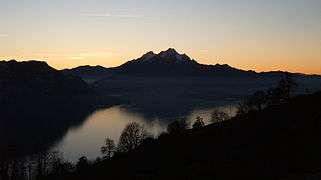 Pilatus and Lake Lucerne
Pilatus and Lake Lucerne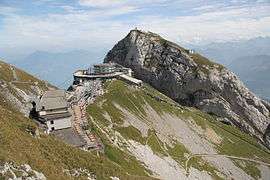 A view of the Hotel and Restaurant, the cog railway top station, and the Esel peak in the back
A view of the Hotel and Restaurant, the cog railway top station, and the Esel peak in the back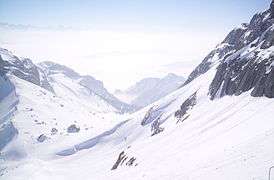 A view from the mountain in winter (March 2006)
A view from the mountain in winter (March 2006) A view from the cog-wheel railway
A view from the cog-wheel railway View from Pilatus towards mount Rigi and Lake Lucerne
View from Pilatus towards mount Rigi and Lake Lucerne
Weather
| Climate data for Pilatus (2106m a.s.l., Reference Period 1981–2010) | |||||||||||||
|---|---|---|---|---|---|---|---|---|---|---|---|---|---|
| Month | Jan | Feb | Mar | Apr | May | Jun | Jul | Aug | Sep | Oct | Nov | Dec | Year |
| Average high °C (°F) | −1.1 (30) |
−1.7 (28.9) |
−0.2 (31.6) |
1.9 (35.4) |
6.5 (43.7) |
9.5 (49.1) |
12.2 (54) |
11.9 (53.4) |
9.1 (48.4) |
6.9 (44.4) |
1.9 (35.4) |
−0.3 (31.5) |
4.7 (40.5) |
| Daily mean °C (°F) | −4.0 (24.8) |
−4.6 (23.7) |
−3.2 (26.2) |
−0.9 (30.4) |
3.6 (38.5) |
6.6 (43.9) |
9.2 (48.6) |
9.1 (48.4) |
6.3 (43.3) |
3.9 (39) |
−0.9 (30.4) |
−3.2 (26.2) |
1.8 (35.2) |
| Average low °C (°F) | −6.8 (19.8) |
−7.3 (18.9) |
−5.9 (21.4) |
−3.4 (25.9) |
1.1 (34) |
4.0 (39.2) |
6.4 (43.5) |
6.6 (43.9) |
3.8 (38.8) |
1.3 (34.3) |
−3.6 (25.5) |
−5.9 (21.4) |
−0.8 (30.6) |
| Average precipitation mm (inches) | 202 (7.95) |
195 (7.68) |
207 (8.15) |
208 (8.19) |
162 (6.38) |
169 (6.65) |
163 (6.42) |
172 (6.77) |
124 (4.88) |
106 (4.17) |
163 (6.42) |
209 (8.23) |
2,081 (81.93) |
| Average precipitation days (≥ 1.0 mm) | 12.7 | 11.6 | 15.0 | 13.9 | 15.0 | 15.7 | 14.2 | 13.9 | 11.7 | 10.5 | 12.1 | 14.4 | 160.7 |
| Average relative humidity (%) | 63 | 66 | 74 | 79 | 82 | 85 | 83 | 82 | 78 | 70 | 67 | 65 | 74 |
| Mean monthly sunshine hours | 123 | 130 | 143 | 137 | 146 | 133 | 159 | 156 | 152 | 159 | 115 | 105 | 1,658 |
| Percent possible sunshine | 50 | 46 | 39 | 34 | 31 | 28 | 33 | 36 | 41 | 49 | 45 | 45 | 38 |
| Source: MeteoSwiss[6] | |||||||||||||
In literature
"The Chalet School does it again" (1955) Elinor Brent-Dyer retells the Pilate burial place legend.
See also
- List of mountains of Switzerland
- List of most isolated mountains of Switzerland
- List of mountains of Switzerland accessible by public transport
- List of mountains of Switzerland named after people
References
- ↑ Retrieved from the Swisstopo topographic maps. The key col is the Glaubenberg Pass (1,543 m).
- ↑ Retrieved from Google Earth. The nearest point of higher elevation is north of the Widderfeld Stock.
- ↑ "Dragon Legends - Pilatus Bahnen". Retrieved 10 September 2015.
- ↑ http://www.strangehistory.net/2011/07/17/dragons-in-swtizerland/
- ↑ http://www.barnhouse.com/composers.php?id=148/
- ↑ "Climate Normals Pilatus, Reference Period 1981-2010" (PDF). Zurich Airport, Switzerland: Federal Office of Meteorology and Climatology – MeteoSwiss. Retrieved 2016-11-14.
External links
| Wikimedia Commons has media related to Pilatus. |
